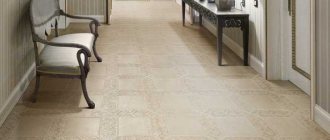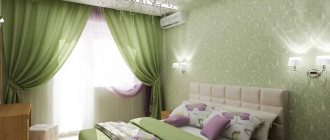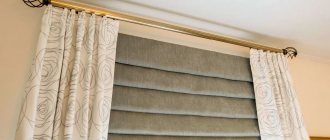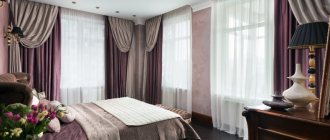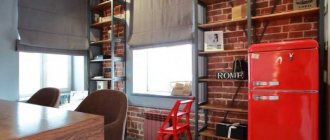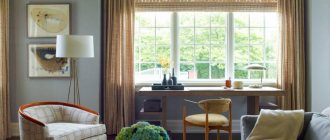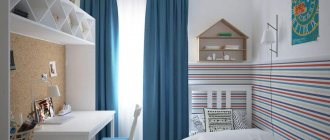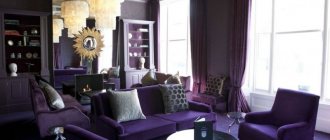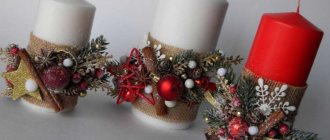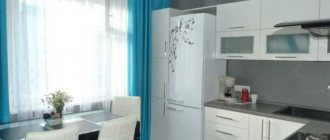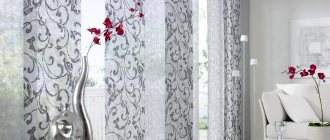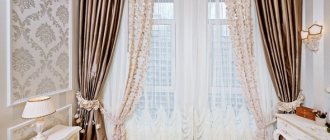Peculiarities
You can decorate the main curtain with a special element called a lambrequin. It has no functionality at all. Looks great in a classic style interior. The design of curtains with a lambrequin fits surprisingly well even into minimalism.
An interesting solution for ready-made curtains with a lambrequin lies in the fact that this element can become a design not only for heavy curtains, but even for curtains.
That is, the curtain becomes decorative. This means that it will no longer protect from the sun’s rays and prying glances. But the image inside the room turns out to be pompous and solemn.
SEW, SEW, SEW. Lambrequins and complex elements of curtain draperies
Patterns of lambrequins and the most complex elements of curtain drapery
On this page you can familiarize yourself with the patterns of the most complex elements of draperies. I hope this helps you with your window decoration.
Equilateral swag.
Construction: 1) We draw a perpendicular to the fold of the fabric, on which we set aside 1/2 of the middle of the swag (1) – AA1 A1A2 = 7 – 10 cm (for processing) AA2 = 0.20 + 0.10 = 0.30 m 2) On the bend we put aside the value (3) - the depth of the swag with k (2) AB = 0.45 x 2 = 0.90 m 3) BV = 1/2 the value (3) = 0.45: 2 = 0.23 m 4 ) From point B we draw a perpendicular to the fold 5) From point B we draw an arc equal to the value of the lower sag (4) - obtained by measuring to the perpendicular drawn from point B, VG = value (4) + 5 cm (for processing), VG = 85 + 5 = 0.90 m 6) Connecting points A2 and D, we obtain value (2) – the shoulder of the swag with k to the depth of the folds being laid.
Swag turning into de jabot.
Construction: 1) Draw a perpendicular to the intended fold of the fabric (at an angle of 45°). On which we set aside the middle of the supposed equilateral swag, value (1) plus allowances for processing - 7 (10) cm. A3a = A - A1A2 = 7 - 10 cm A3A2 - middle of the swag = value (1) + 14 (20) cm (for processing ) 2) On the expected bend we set aside the swag depth - value (3) with coefficient (2) B = value (3) x k (2) 3) On the expected bend from point B we set aside 1/2 of the swag depth - value (3) BV =1/2 the value (3) 4) From point B we draw a perpendicular to the fold along the entire width of the fabric (1.40 m) 5) From point B we draw an arc equal to the value of the lower sag (4), obtained by measuring to the drawn perpendicular from the point B. 6) Connecting points A3 and G, as well as A2 and G1, we obtain the shoulders of the swag with k assembly to the depth of the laid folds 7) G1D - the size of the de jabot along the cornice with k assembly - to the depth of the laid folds. From point D we draw a perpendicular, l – 1.45 m (width of the fabric). 9) DD1 – de jabot height. 10) GD1 - an arbitrary line of the lower sag of the swag, turning into de jabot (depending on the model).
On which we set aside the middle of the supposed equilateral swag, value (1) plus allowances for processing - 7 (10) cm. A3a = A - A1A2 = 7 - 10 cm A3A2 - middle of the swag = value (1) + 14 (20) cm (for processing ) 2) On the expected bend we set aside the swag depth - value (3) with coefficient (2) B = value (3) x k (2) 3) On the expected bend from point B we set aside 1/2 of the swag depth - value (3) BV =1/2 the value (3) 4) From point B we draw a perpendicular to the fold along the entire width of the fabric (1.40 m) 5) From point B we draw an arc equal to the value of the lower sag (4), obtained by measuring to the drawn perpendicular from the point B. 6) Connecting points A3 and G, as well as A2 and G1, we obtain the shoulders of the swag with k assembly to the depth of the laid folds 7) G1D - the size of the de jabot along the cornice with k assembly - to the depth of the laid folds. From point D we draw a perpendicular, l – 1.45 m (width of the fabric). 9) DD1 – de jabot height. 10) GD1 - an arbitrary line of the lower sag of the swag, turning into de jabot (depending on the model).
Classic tie
Double swag with a bell.
Construction: 1) Draw a perpendicular to the fold of the fabric, on which we set aside the value ab = 25 cm + aa1 (7 cm for processing) + value bd1 (1/2 the width of the bell - 12 cm) = 44 cm 2) On the fold we set aside d1d = 20 – 25 cm (the value depends on the drape of the fabric) 3) From point b, draw a perpendicular downwards = value d1d + 3 (5) cm (for processing folds and bells) vv1 = dd1 + 3(5) cm gb1 – cut 4) From point d to the fold we draw an angle at which we set aside 1/2 the width of the bell bd1 = gd (4 + 8 = 12 cm) 5) Along the fold from point d1 we set aside the value w with k (2) - point T; T = 0.45 x 2 = 0.90 m; with k (1.8) – 45 x 1.8 = 81 cm 6) From point T we draw a perpendicular to the fold 7) From point d we plot the value of the bell l (0.40) From point T upward we draw an arc equal to the value be( according to the sketch, obtained by measurement) = 1/2 the value of the lower sag + 1/2 the width of the bell 80 + 16 = 96 ve - the expected cut of the swag 9) By connecting points b and a1, we obtain the shoulder of the swag with k for the assembly of draped folds.
T = 0.45 x 2 = 0.90 m; with k (1.8) – 45 x 1.8 = 81 cm 6) From point T we draw a perpendicular to the fold 7) From point d we plot the value of the bell l (0.40) From point T upward we draw an arc equal to the value be( according to the sketch, obtained by measurement) = 1/2 the value of the lower sag + 1/2 the width of the bell 80 + 16 = 96 ve - the expected cut of the swag 9) By connecting points b and a1, we obtain the shoulder of the swag with k for the assembly of draped folds.
Fabrics
Various fabrics are suitable for making a set of curtains with lambrequins. More often these are heavy curtain options or airy chiffon.
But today designers do not limit themselves to imagination. They create magnificent products from various materials that they can combine. The compositions are amazingly beautiful.
Bedroom
The bedroom, unlike the living room, which is capable of creating an explosion of emotions, determining status and gathering the whole family into a single whole, must protect the peace of its owners.
Roman blinds for the nursery
Modern ideas for boys and girls. 250 designer photo tips
Adviсe
More details
Roman curtains in the bedroom interior
Ideas for decorating windows with photos
Adviсe
More details
Roller blinds
Selection of roller blinds for the interior of the kitchen, balcony, nursery, living room and bedroom. 50 photos
Adviсe
More details
Hard lambrequin
The calm, straight lines of the wall decor allowed the designer to abandon the use of fabric lambrequins, replacing them with a wide, rigid baguette that matches the color of the room’s walls. This reduces emotional stress, makes it possible to relax and fall asleep, and in the morning concentrate on the pieces of furniture in the interior.
rashad__curtain_gallery
nur.perde.istanbul
Blue bandeaus
Upholstered furniture in the bedroom does not belong to a specific style, performing only one task - to give a person a rest. The lack of style determined the possibility of using a rigid bandeau with right angles and a relief white border made of wooden planks as a lambrequin. It attracts attention with its unusual shape and purple color, symbolizing calm and tranquility.
interiorswithbukiss_kutz
nur.perde.istanbul
hamed_masrourfard
Canopy
Decorating a bed with a canopy is extremely rarely used in modern bedrooms, but it was nevertheless widespread like decorating window openings more than three hundred years ago. Lambrequins on all sides of the canopy serve as a connecting link between the gilded decor of the panels, pillars, headboard, side slats of the bed and fabric curtains.
hamed_masrourfard
Blue Swags
The lambrequin, created by blue swags with gilded fringe and a rigid gilded cornice above them, forms a modular design that is integral with the curtain hanging above the bed. All together this protects the owner from morning and moonlight.
hamed_masrourfard
beddinginn
Two swags
The simple design of a soft cornice made of two swags attracts little attention, fulfilling its main tasks - to close the wooden cornice and hide from view the attachment of two identical narrow curtains, assembled with side hooks.
hamed_masrourfard
French style
Wide fabrics of light brown color, divided into vertical stripes in the form of three festoons, limited on the sides by hanging jabots, serve as lambrequins for two closely standing windows in the bedroom, which has access to the south side. A special feature can be called their color, repeated on the border of the sliding dark-colored windows. purple curtains, corded tiebacks and bells made from fringe.
hamed_masrourfard
Huge swag
The high – about four meters – ceilings of the bedroom require placing monumental curtains on the large window. The designer did not split up the space with small details of sliding curtains. He simply created a two-meter-wide and one-meter-high swag under the ceiling and attached an Italian single curtain to it, assembled with a side hook. The fabric was plain gold brocade with a white border embroidered with gold threads.
hamed_masrourfard
Gold brocade over the bed
The main decorative element, without which it is impossible to perceive the room, is a wide lambrequin made of gilded brocade, folded in the manner of a French curtain. Moreover, the two central swags are located higher - just under the baguette, and the two side swags go down to the headboard, reaching it with the long tongues of classic frills. The designer was not satisfied with the original version of a lambrequin of three gray swags, and he placed a lambrequin made of gilded brocade on top of them, distracting all the attention.
hamed_masrourfard
Hard
Rigid variations, called bandeau, fit perfectly into any style direction. This is a beautiful plank with a cut that can be straight or curly.
Products with carved patterns are ideal for rooms with low and high ceilings. By the way, this number will not work with soft structures, since such curtains are suitable only in rooms with ceilings of at least 2.5 meters.
Curtains with lambrequins for the hall can be made with both soft and hard variations of the lambrequin.
Lambrequins for a hall without curtains
Lambrequins can be used to decorate windows as an independent component - without curtains, depending on the shape of the window, the style of the interior and your preferences. However, most often, lambrequins without curtains are used to decorate kitchen windows (due to the small size of the room and/or small-format windows). But lambrequins without curtains will be quite appropriate in the hall if:
- the size of the hall is small;
- there are small windows in the hall;
- from the living room there is access to the balcony;
- your living room design has an oriental style.
It is necessary to clarify what is meant by the words “no curtains”. If we are talking about the living room, then it would be more accurate to say - without curtains, but only in combination with light tulle curtains. A bare window does not look aesthetically pleasing. In addition, it is necessary to provide at least light shading, comfort in the room and protection from the street.
We also recommend: What types of balcony blinds are there and which ones are best to choose?
When experimenting with models of lambrequins and curtains, remember that your ideas must match the style of the living room interior, and the textile decorations of the windows must fulfill their traditional functions necessary to ensure comfort in the room.
Soft
This type of lambrequins varies according to the type of fabric. The most popular are satin, filling the room with aristocratic notes.
Veiled models will bring solemnity to the room. Openwork, made in different techniques, is easy to make yourself. The lace element brings lightness and airiness to the atmosphere.
Recommendations from the designer
Gray curtains in the interior - stylish options for using gray color and features of its use in design (70 photos)
- Openwork curtains - beautiful design, selection rules and application features (110 photos + video)
Curtains with eyelets - examples of stylish design, tips for choosing and options for using curtains (85 photos + video)
Types of lambrequins
The main difference between this decorative decoration is the choice of base for production, style and finishing details. The possibilities with these curtain accessories are endless. Wide possibilities for choosing styles, colors and fabrics, lining, length and shape of edge trimming make lambrequins a unique and versatile decorative part of a curtain design.
Lambrequins according to the manufacturing method are conventionally divided into two groups:
- hard;
- soft.
Hard
The rigid lambrequin completely hides the fastening system and the cornice itself. Choose any shape that suits your windows - with smooth, rounded or curly edges. A rigid lambrequin can be additionally equipped with decorative elements. Edging, braid, tassels - all this adds aesthetics to the design of lambrequins.
Bando
This lambrequin is a rigid base on which fabric is stretched without folds. The bandeau usually covers the cornice, has a flat or shaped bottom edge, and can have different configurations. Usually covered with the same fabric as the curtains (for example, thick jacquard fabrics) or felt.
A rigid lambrequin is simple in outline and, with its intelligent restraint, can decorate not only the hall, but also other rooms.
Bando can also be made on a soft base, without the use of plywood or plastic. In this case, the outer layer of the main fabric is attached to the lower soft base, which is made either from felt or from very dense fabric, folded in 2-3 layers, giving it the desired shape in advance.
Soft
Soft types of lambrequins are made from both light and dense fabrics. Fabrics that drape easily and form soft folds are best.
Complex fabric structures can be assembled from different elements and can be decorated with decorative elements:
- fringe;
- brushes;
- cords;
- others.
Materials for production
It is important to choose the right fabric. As a rule, curtains and lambrequins are made of the same materials. However, for their manufacture, you can choose any fabric, selecting color shades and patterns that match the style of your room:
- tulle fabrics (veil, chiffon and others);
- thin curtain fabrics (silk, linen and others);
- dense curtain fabrics (satin, jacquard, velor, velvet and others).
Before designing a window opening, decide on the basic concept of the interior design, then choose the fabric. At the same time, it is appropriate to remember that dense materials of dark colors visually reduce the space, and with the help of light and light fabrics you can visually expand it.
Drapery forms
Soft lambrequins differ in the methods of assembly and arrangement of folds (drapery forms):
- svagi - the most common form, which consists of folds of fabric elegantly hanging in the form of semi-arches from the top of the curtains;
- semi-swagi (throwovers) - a strip of fabric, folded, is thrown over the curtain rod, one end is attached to the cornice or the top of the curtain, the other end hangs freely;
- molds - vertical sharp-angled folds with folds placed inside or outside the product; is located, as a rule, in the center of the lambrequin;
- Jabot (de Jabot) is an asymmetrical element framing the edges of the curtains. The draping of the fabric in folds with corners resembles a frill: the shortened side usually “looks” into the middle of the window space, the long side is directed outward;
- tie - a decorative item folded into folds with the short side directed outward. Reminiscent of a jabot, but narrow and much smaller in size;
- bell (bell) - a piece of fabric folded in the shape of a cone, made exclusively from dense materials to maintain its shape;
- simple assembly - a strip of fabric is 1.5-2 times longer than the cornice. The entire strip of fabric (frill) is gathered (pulled together) on the cornice. It can be attached separately to the cornice using a drawstring through which a round cornice is threaded, or attached to rings, or attached to the top of the curtain panel. The assembly is distributed along the entire length of the cornice.
Combined
Combined lambrequins are a symbiosis of different models of lambrequins: for example, a rigid bandeau with openwork decor, or with soft fabric folds repeated in different sequences, or other options.
Combined lambrequins are the most pompous and solemn. Such lambrequins look great in spacious living rooms with high ceilings.
We also recommend: What to consider when choosing curtains
However, exercise restraint in your desire to decorate the curtains, avoiding going overboard with the number and appearance of details.
Decorating the windows in the living room
The veil looks airy. Suitable for both the living room, bedroom and children's room. Differences in shape:
- vertical folds folding into an acute angle - a mold;
- folds in the form of an arch - svagi;
- asymmetry on the sides with a beveled corner - de jabot;
- a side element, already de jabot, with folds in the form of an accordion - a tie;
- fabric folded into a cone, holding its shape - a bell.
Lesson 21. Sewing a lambrequin with two-color swag.
two-color swag
I will cut the swag according to a ready-made pattern. The equilateral swag is green and the asymmetrical cross is white.
In green swag, I overcast the bottom edge, collect the folds and hang them on a block:
In a white asymmetrical throw, I overcast the top edge and finish the bottom edge with bias tape. I hang it on a block under an equilateral green swag in such a way that the lower fold of the equilateral swag is wrapped in the upper fold of the asymmetrical swag. Like this:
sewing a lambrequin
Next, I lay all the folds in an asymmetrical fold. It turns out that the symmetrical swag (green) is somehow inserted into the asymmetrical switch (white):
Master Class
As a result, we get a two-color swag:
Next, I make a two-color dejabot. To do this, I cut out the relevant details:
We fold the parts inside out and sew a line:
This is what you should get from the reverse side of the dejabo:
If you would like to receive new articles from the site by email, then:
And this is the view from the dejabo’s face after the seams are overcast:
Now I finish these seams myself with bias tape. Here's the result:
I gather the dejabo on the table into folds and add it to the swag on the block:
I also make and add a mold to the block:
I will not dwell on how to make a dejabo and a mold, since this is discussed in more detail in lesson No. 9.
You can also read lesson No. 16, which tells you how to make a two-color mold and dejabo.
Next, when all the details of the lambrequin are hung on the block, I pin the bar to them and sew it on.
How to sew a strip to a lambrequin, see earlier master classes, where I described several ways to make it (the strip).
I decorate a sewn lambrequin with a flower made from curtain fabric:
The lambrequin with two-color swag is ready. The length of this lambrequin is 1.3 m. However, you can sew a lambrequin 2 and 3 meters long if you add one or two more swags and two dejabos on the sides. This depends on how long your cornice is.
Or you can between two two-color swags No. 1 (length along the cornice: 105 cm, with asymmetrical crossover, sagging height 55 cm):
Insert two-color swag No. 2 (length along the cornice 118 cm), with a symmetrical crossover, sagging height 55 cm
HERE you can find out how to make patterns for these two-color swags:
2012-10-02_150342
After reading this master class, I suggest you watch an interesting video about decorating a kitchen window with curtains:
Colors
There are no color restrictions, you can choose any option:
In living rooms, the best color palette is beige, burgundy, steel, gold, pink, brown.
Green, beige, and peach tones are ideal in the bedroom. The kitchen will shine with red, orange, pink colors, because this is where they appear best. By the way, the kitchen “loves” floral prints and checkered patterns.
Photos of curtains with lambrequins for different rooms can be viewed on various resources.
Possibilities of decorative drapery
With a creative approach and skillful combination of elements, you can create original options for decorative drapery. In addition to the function of decorating the upper edge of the curtains, lambrequins can be used to cover the cornice or imperfections in the fastening of the main curtain panels (if necessary).
A large number of different ways of laying fabric add uniqueness to the living room environment. A large selection of colors, styles, and fabrics allows the products to harmonize with any interior, create a pleasant atmosphere, give windows unique outlines, and receive visual pleasure.
We also recommend: Can't find curtains for your living room? We will help!
Rooms
When choosing a lambrequin, focus on the functionality of the product, style and size of the room.
Recommendations from the designer
- Black and white curtains - stylish examples of design and amazing combinations of black and white (95 photo ideas)
Curtains for the bedroom: modern real ideas for use in the interior. 105 photos and videos of the best solutions
Black curtains: beautiful ideas for using design, choice of fabric and review of combinations (120 photos)
They bring luxury to the room. It is better if it is in the same tone as the curtain, but without repeating it. For example, basic brown and beige-toned swag go perfectly together.
The bedroom is a place where we can relax and unwind. The model is selected taking into account the style and ceiling height.
If you decide to install blinds or blackout, then a bandeau is perfect.
In the kitchen it is better to use soft variations of drapery. The fact is that a bandeau is not suitable here, because it is difficult to care for rigid structures.
As you already understand, curtains with lambrequins can be sewn with your own hands, but it is better if you order them from craftsmen.DIY swag pattern: master class for beginners
It is difficult to imagine a beautiful, complete interior without perfectly matching curtains.
The market offers such a wide selection of types and colors of window treatments that you can easily get lost in it. Some resort to the help of designers, while others cope on their own. In the second case, you can pay attention to such a detail as swag. You can make such curtains yourself, the main thing is to stock up on expert advice. Beautifully decorated window openings can give even the most trivial interior charm and a sophisticated appearance.
Exquisite curtains are not only a decoration for a room, they help create a cozy atmosphere that allows you to rest and unwind after an active day.
What is swag?
Those who are faced with the process of choosing new curtains for the first time often ask the question “What is swag?” Swag is one of the elements that can be used to decorate curtains, namely an addition to the lambrequin (its upper part); it is draped in a special way. It looks like a semicircle with folds on it. It consists of a head and shoulders (some call them wings).
Curtains can look like a real work of art if swags are used to create them.
Depth is the degree of its sagging, length is the length that this element occupies on the cornice. Next comes the middle part - the middle along the cornice. The shoulder is the part with drapery folds and other fabrics. Even when preparing a pattern, you come across the concept of “sag” (the third name is “depth”), this is the length by which the lower part can fall from the upper. Usually the difficulty is in arranging them correctly, but if done correctly, they will become a real highlight in the style of your room.
If you imagine exquisite, expensive curtains, then most likely they will be decorated with a lambrequin with swags.
Swag is used as a decorative component when sewing elegant and luxurious curtains.
Types: what are they?
Equilateral swag
This is usually used if there are other decorative elements on the curtains, since it does not overload the composition and looks symmetrical, its shoulders are the same.
Swag is used to decorate a window opening.
In order to speed up the sewing process, you can use a ready-made pattern. List of main parameters that must be taken into account when sewing a swag with equal sides:
It is part of a horizontal soft lambrequin, which is designed to give the curtains a sophisticated and sophisticated appearance.
Asymmetrical swag
This species will have different shoulders: one is wider and the other is narrower.
Despite the fact that swags are considered an integral element of the classical style, this does not mean that they are not used in other stylistic directions.
We will describe how to cut and calculate the parameters of the swag. To build this element, you can choose a fabric measuring 140*140, then divide this segment with chalk into two halves diagonally. Then you need to draw lines in both directions that will be equal to half the length of the element; we do this perpendicularly. At the ends of the resulting line we place point No. 1 and point No. 2.
The correct selection of colors and textures will help revive a room decorated in the Art Nouveau and even High-Tech style, bringing its share of the avant-garde.
Important! It is imperative to take allowances into account in order to process the edges later (approximately 05. – 1 cm).
At an angle of 15 degrees from points 1 and 2, you need to set aside segments that will be the same in length as the swag’s shoulder (if you don’t trust your eye, use a protractor). At the ends of the segment you need to put point No. 3 and point No. 4.
“Svag” translated from English means “garland” or “leaf-shaped ornament.”
On the diagonal itself, you need to cancel the sagging depth (let it be marked as point A), connect points A and 3, as well as points A and 4 with an arc. The pattern is ready.
Do-it-yourself swag: how to make patterns? Step by step description
Sewing this element is a rather complex and multifaceted process. It can take a lot of time to master the art of sewing and become a professional at it, but for beginner seamstresses and hobbyists there are simpler methods by which you can sew a curtain.
It is made in the form of a semicircle, sagging freely, and consists of beautiful draped folds.
You shouldn’t be scared, because according to the instructions of this easy method, anyone can sew such curtains. The whole point is that you can sew not only a classic swag, but also a simpler one to make - a mechanical one. Its peculiarity is that folds can be made not by hand, but by resorting to tricks and using mounting tape, or you can come across such a name as curtain tape. At the same time, it is almost impossible to distinguish this option from the one that was created manually. Therefore, this alternative is not at all inferior to the classical method. So, a small master class on sewing an equilateral swag.
Several swags can be used simultaneously in one lambrequin, which are arranged as if overlapping each other.
Often between them you need to sew an additional decorative element that will fill the resulting space.
As a standard, these elements are sewn with a height of 35 cm and a width of 60. These dimensions may vary slightly, depending on the size of the window and the desired effect. We will use the following parameters:
- length 90 cm;
- depth 45 cm;
- the bottom sag is 140 cm.
Swags do not always have the same width, for example, the central element may be smaller than the side parts.
From these measurements it turns out that:
A – half (of its middle) – 15cm
B – depth – 45 cm
G – half of the lower sag – 70cm
Being at different heights from the cornice, they form a two-level composition.
You can decide on your own what size your swags will be by slightly editing the patterns.
We create patterns to sew swags
The first step is to construct an angle with vertex (1). From it to the right you need to set aside a segment that will be equal to half the middle + 3 cm for processing. It turns out 18 cm. The second end of this segment will be point No. 4. Next, we also measure a segment from point No. 1, the length of which will be equal to the depth parameter multiplied by k, where k is equal to 2 - 2.5.
Creating a swag is quite a troublesome and painstaking task, but there are easier and simpler options, for example, “shell”.
Additional Information! This indicator depends on the chosen fabric: if we are working with dry fabric that is stiff enough for draping, then it is better that this indicator is equal to 2. But if the fabric is soft and easy to drape, then it is better that in this case k is equal to 2 ,5.
Even a novice craftswoman can drape such an option. It received this name due to its similarity to a sea shell.
Next step: from point two we draw a circle. Instead of a compass, you can use a thread, attaching it to point No. 1. After this, on the resulting arc from point No. 2, mark point No. 3. it should be in half of the lower sag, and, of course, do not forget about the additional 3 cm for processing. We connect points No. 3 and No. 4 with a straight line, and the angle that will be obtained at point 4 will be slightly rounded. As a result of the work done, we get a figure (1-2-3-4) - it will be the basis of our pattern. We will make the stitching of the mounting tape along line 1-4-3, and the tie on section 4-3. The middle (1-4) is not tightened, but only processed.
There are several varieties of this element for decorating window openings, each of which has its own flavor and is characterized by distinctive features.
Usually this element is sewn on a lining, but using soft fabric you can do without it. So, we have half of the pattern ready.
Swags come in a variety of designs, including two-level ones.
Additional Information! In this case, you can cut at an angle of 45 degrees, or you can cut along the warp thread, this is even more convenient.
This type is located in a horizontal plane relative to the entire curtain fabric at the same height.
When you start sewing, work the side that lies between points 2 and 3 using a bias stitch or a double bend. On those sides to which the curtain tape will be sewn (1-4-3), turn the seam allowance inside out and then iron it. From the wrong side we stitch the curtain tape. We tighten side 4-3, and leave the middle (1-4) unstretched. Now the pattern is ready!
This model can also have asymmetrically laid shoulders.
With the transition to de jabot
Curtains can be made even more unusual and original if you use the technique of transition to de jabot. This option can replace two components of a lambrequin at once; in addition, it allows you to avoid primitive and boring design solutions.
Thanks to the presence of such an element, you can create decorative patterns from curtains, giving the room sophistication and elegance.
Accordingly, the pattern will consist of two parts: the swag pattern, which will be attached to the de jabot pattern. So let's get started.
It is necessary to select the material for such an element with special care, since the entire appearance of the resulting composition depends on it.
- We are building a swag pattern. In the previous paragraphs, we have already looked at how to make a pattern for an asymmetrical and ordinary element.
- We attach an element de jabot to this pattern. How to make a pattern for it? Let's look further.
- On the perpendicular to the fold of the fabric aB from point G1, mark the distance G1D, it will be equal to the length of the finished element de jabot along the cornice, taking into account the folds.
- From point D we draw a perpendicular to line G1D and measure the height of the de jabot on it (in the figure this is point DD1)
- All that remains is to draw the sag line.
If you want the folds of the swag to be soft, then opt for fabric that drapes easily.
The swag pattern with the transition to de jabot is ready!
Conclusion
Such curtains can really significantly diversify the interior. Many housewives note that swags give a fresh effect to the room, adding freshness, novelty and unusualness to it. Some people note that they are convenient for decorating a room, for example, they are convenient for attaching New Year’s decorations to. In general, this can become not only an aesthetic addition to the decor in the room, but also a functional element for additional decoration of the apartment.
If the curtains are made of tulle, this will create a romantic atmosphere in the room.
VIDEO: How to lay an asymmetrical swag.
Photo of curtains with lambrequin
Read here! Curtains for curtains - 100 photos of the best design ideas and the nuances of their use in interior design
Please repost
2+
Beautiful lambrequins for the hall - photo
We offer a selection of photos with samples of lambrequins for the hall: classic and modern models (including new items), for your inspiration when creating an exquisite design for the windows of your living rooms.
Lambrequins with tulle for the hall
Sometimes windows are covered with one type of curtain, for example, curtains. They always look too simple. In combination with lambrequins, the window will look more stylish and delightful due to their airiness. To prevent such a tandem from looking dull, lambrequins for the hall, as well as tulle, should be chosen in different color shades.
Colors can be very different, from milky to rich, bright.
In this case, light colors act as a background. The central tone is selected from bright colors. This combination fits harmoniously into any room setting. There are many combinations of lambrequins and curtains. New decor items for 2021 and options for some solutions can be seen in the photo.
A velvet lambrequin with an airy curtain to the floor looks stylish. A combination of soft pleated tulle and tulle fixed on a rod, especially decorative. To create a romantic style, you can use lace sewn in several layers. They will let in daylight and look charming on the window. Colored tulle can be combined with lambrequins in the hall, made with a similar pattern.
Several interesting combinations for the hall:
- The base is matte in a tulle pattern. A two-color lambrequin is selected for it, and one of them should duplicate the base. Additional details – swags and frills. This classic variation will give the room solemnity and elegance.
- Short tulle with long curtains and a lambrequin is a good option for creating an unsurpassed masterpiece.
- Lambrequins and tulle in warm colors look elegant.
- Tulle, curtains and bamboo curtains, lambrequins in the hall - a combination that creates a feeling of luxury.
